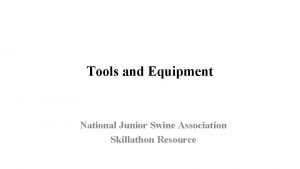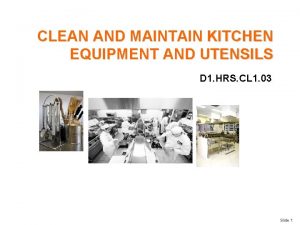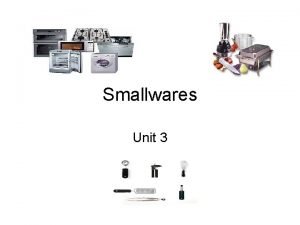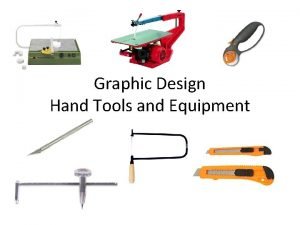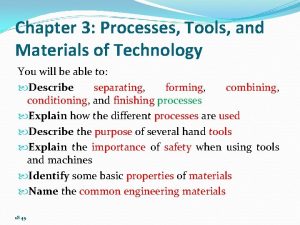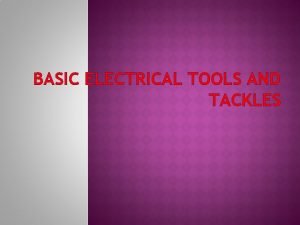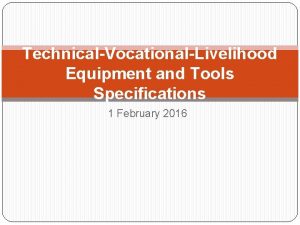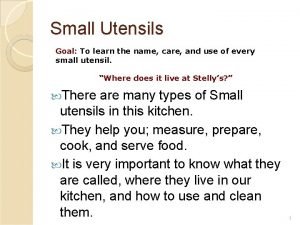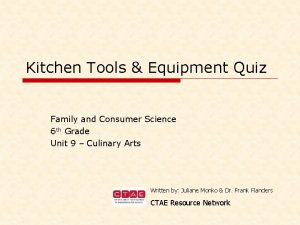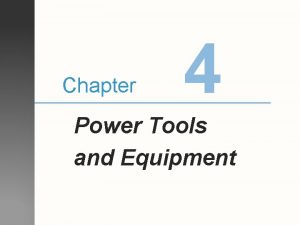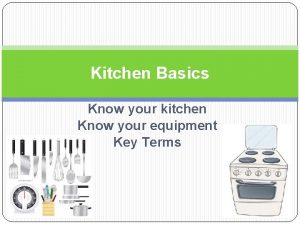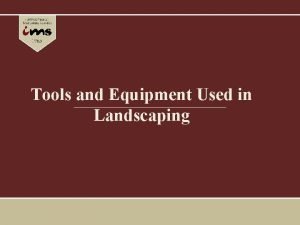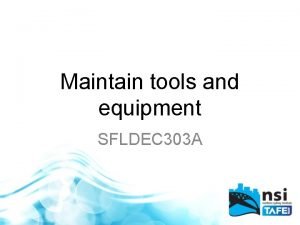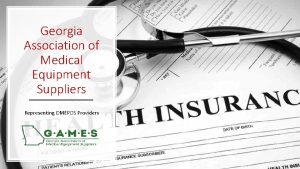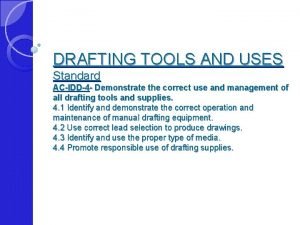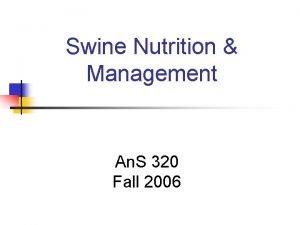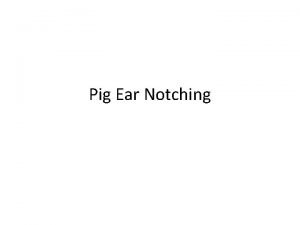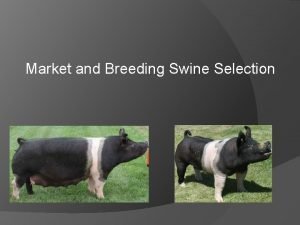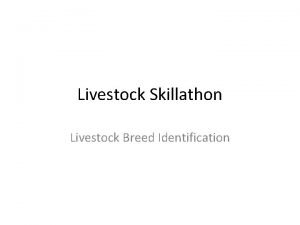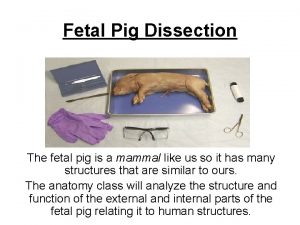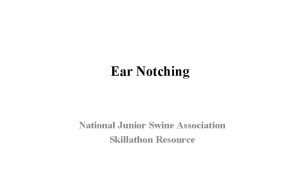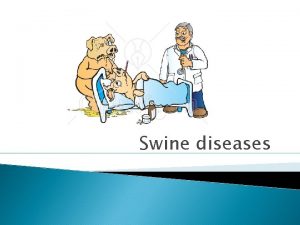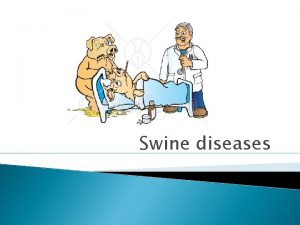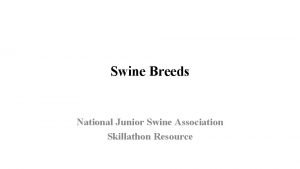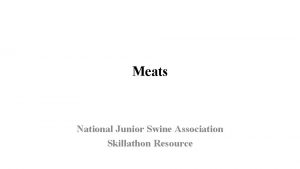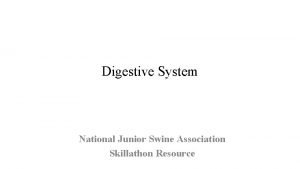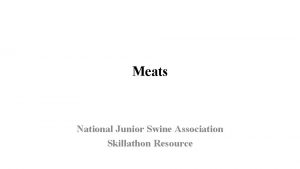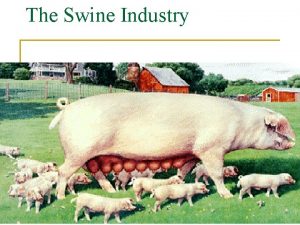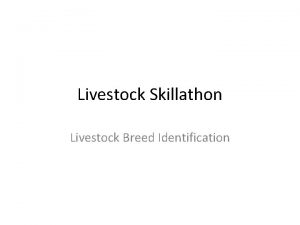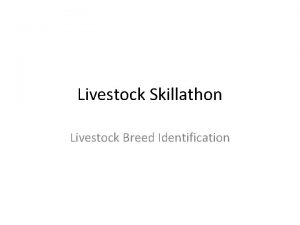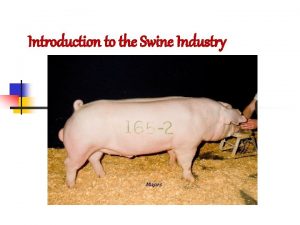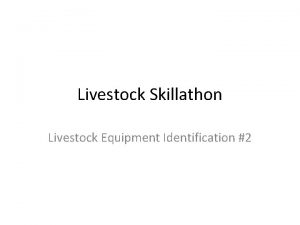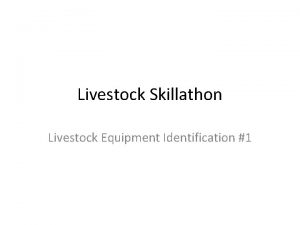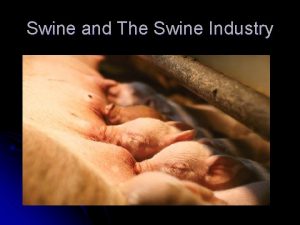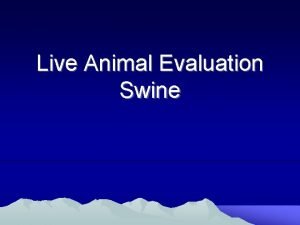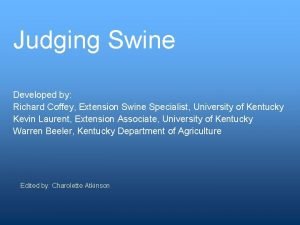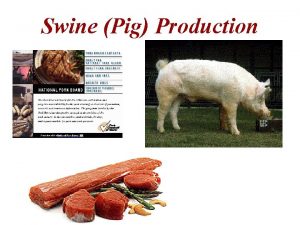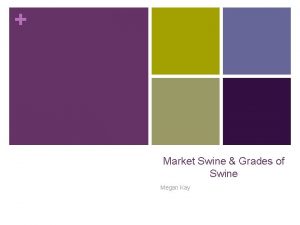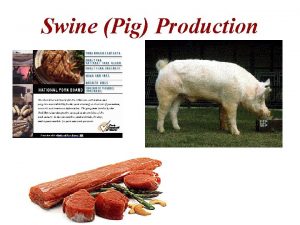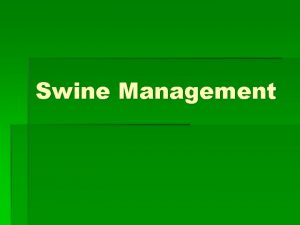Tools and Equipment National Junior Swine Association Skillathon






































- Slides: 38

Tools and Equipment National Junior Swine Association Skillathon Resource

Learning Objectives • This resource should teach you how to identify tools and equipment that are utilized in the swine industry. • Upon completing this resource, you should be able to: – Identify the tool or equipment by its correct name – Understand the purpose for the tool and its use in the industry – Comprehend how to safely and effectively utilize the tool

Ear Notcher • The ear notcher tool is used to notch the ears of baby pigs. • Ear notching is used to identify the pigs. • Ear notching is typically done within 7 days of birth, and is often accompanied with iodine to prevent any infection from occurring. **You can learn more about how to ear notch and how to read ear notches in the section titled “Ear Notching”.

Syringe/Needles • Syringes are used to administer medications to animals. • They are typically plastic and have measurements down the side to properly measure the correct dose of medicine. • It is extremely important to replace the needle after using and to place old needles in a safe, puncture-proof sharps container. Syringe Sharps Container

Dose Injector • A dose injector is a safe way to ensure that each animal gets the proper dose. • Since human error can lead to the use of both too much and too little medication, a dose injector can be programmed to allow a producer to use medications effectively.

Scalpel • A scalpel is a common tool that is used in castration. • The scalpel is used to make either two vertical cuts or one horizontal cut to the scrotum followed by cutting the spermatic cord and removing the testes.

Preg-Tone • Preg-tone is an ultrasonic pregnancy detector. • It uses ultrasound to detect amniotic fluid present during pregnancy. • When this fluid is detected, the instrument produces a loud, continuous tone, indicating that the animal is pregnant. • If the animal is not pregnant, it produces an intermittent (static) recurring tone.

OB Snare and OB Forceps • An OB snare and OB forceps are tools utilized during farrowing. • If the sow is having trouble, these tools can provide assistance to remove piglets. • NOTE: You should have practice using these before as you could harm the sow and/or the piglet if used improperly.

Livestock Marking Crayons/Paint Stick • In order to identify which pigs have been treated in a facility, farmers may use a livestock marking crayon, or paint stick, to identify the animals.

Ear Tagger • Some shows or events may require an ear tag as an additional form of identification. • The ear tagger is shown below with some examples of ear tags. • An Ear Tagger is used to put tags in pigs ears. • Ear Tags are used to identify pigs.

Show Tools: Pipe/Whip • When showing in the ring, you want to use a driving utensil that is familiar to the pig. • You want to have control of your animal. • Some animals respond better to whips, and some respond better to pipes. • The pipe and the whip are the most common types of driving utensils in the swine industry.

Clippers • You want to make sure your pig is presented properly on show day. • By using clippers such as these in addition to various head guards, you can trim your pig’s hair and make your project ready for the winner’s circle. • Be sure to check any hair length requirements before trimming your pigs for specific upcoming shows. Clipper Blades Head Guards

Nipple Water • Nipple waters are used as a way to provide continuous clean drinking water for pigs. • Keeping your pigs hydrated is a key component to their growth and success in the show ring.

Respiratory Mask • These respiratory masks can be worn when entering swine facilities. • These can prevent the transmission of zoonotic diseases and is a necessary precaution, especially in large swine operations. • These masks can also prevent the inhalation of dust and other substances that could be harmful.

Herder/Sorting Board • Herder boards (sorting boards) can be used to help with stubborn or difficult pigs. • They can help load pigs on the trailer or separate pigs from fighting in the ring. • Many people who work the ring at shows carry a herder board to assist them in penning pigs, separating fights, and keeping pigs out of corners.

Plastic Boots • When entering swine facilities, it is important to wear these plastic boots. • These help prevent the spread of disease from operation to operation. • Wearing these boots is a good way to practice sound herd health management and biosecurity.

Tooth Nippers • When processing a litter of pigs, it is important to clip the needle teeth and clip the tail. • By clipping the needle teeth, you are getting rid of four very sharp teeth that could cause the sow discomfort when nursing. • Tails are also docked so that they are not too long and get stepped on by the mother or the other piglets. • Tail docking is often accompanied with iodine as well to prevent infection. • A pair of tooth nippers such as this will serve to clip the needle teeth and dock the tail.

Pig Snare • Sometimes, a snare is necessary to use in order to give a pig a shot or to trim difficult areas on your pig’s body when clipping for a show. • Pictured below is an example of a snare that could be used for such purposes.

Thermometer • Thermometers such as this can be used to take your pig’s temperature when it may seem to be sick. • A normal temperature for a pig is between 101. 5 and 102. 5 degrees Fahrenheit.

Artificial Insemination Breeding Rods • Artificial insemination rods, or spirettes, are used to inseminate a gilt or sow with boar semen. • When using the rod, it should be inserted at a slightly upward angle (45 degree angle) and be turned counterclockwise until it locks into the cervix. If using a foam tip rod, it does not need to be turned. • Once the breeding rod is locked into place, the semen tube can be placed in the tip of the rod.

Self Feeder • This is an examples of a type of self-feeder for swine. • Many hogs are put on a self-feeding diet, especially early in their life. • Through this, they have unlimited access to food throughout the day.

KNOWLEDGE CHECK! Complete the following quiz to see what you learned about tools and equipment in the swine industry. Begin Quiz

1. What tool is pictured below? Thermometer Syringe Spirette Scalpel

TRY AGAIN! Remember that this tool is used for artificial insemination. Which tool would be helpful in artificial insemination? Back

CORRECT! This is a spirette, otherwise known as an artificial insemination rod. Next Question

2. You would primarily use a scalpel during _____. Farrowing Castrating Weaning Ear Notching

TRY AGAIN! Think about what each of these tools would be used for. Remember a scalpel is like a small surgical knife. Back

CORRECT! A scalpel would be used in castration. Good work! Next Question

3. What should be placed in the image below? Used Plastic Boots Old Feed Used Needles Trash

CORRECT! Used needles should be placed in a punctureproof sharps container. This prevents the spread of disease and infection and prevents injury from needles. Next Question

TRY AGAIN! Think about what you would place in these containers! Back

4. Which tool is an ear notcher?

TRY AGAIN! Go back and review the tools and equipment if needed! Back

CORRECT! Great Job! You correctly selected the ear notcher! Next Question

5. Which of the following helps prevent the spread of disease and/or infection? Wearing plastic boots Using a respiratory mask Spraying iodine on docked tails All of these options help with prevention.

TRY AGAIN! This may be true…but read all of the choices! Back

CORRECT! Very Good! All of these actions will help prevent disease and infection! End Quiz

CONGRATULATIONS! You completed the “Tools and Equipment” Skillathon Resource! Keep working hard to learn about the Industry!
 Swine tools and equipment
Swine tools and equipment Clean and maintain kitchen tools equipment and premises
Clean and maintain kitchen tools equipment and premises What is arista national honor society
What is arista national honor society National junior honor society essay ideas
National junior honor society essay ideas National junior honor society application answers
National junior honor society application answers Difference between tools and equipment
Difference between tools and equipment Spatula
Spatula Graphic design tools and equipment
Graphic design tools and equipment Loopback adapter
Loopback adapter Tools equipment and processes
Tools equipment and processes 11 classification of hand tools
11 classification of hand tools Basic electrical tools and their uses
Basic electrical tools and their uses Tvl tools and equipment
Tvl tools and equipment Hand tools and small equipment
Hand tools and small equipment Kitchen tools quiz
Kitchen tools quiz Chapter 4 power tools and equipment
Chapter 4 power tools and equipment Tools utensils and equipment needed in egg preparation
Tools utensils and equipment needed in egg preparation Cutting tools in mechanical workshop
Cutting tools in mechanical workshop Unit 5 tools and equipment
Unit 5 tools and equipment Auxillary cooking equipment
Auxillary cooking equipment Tools and equipment for the bakeshop
Tools and equipment for the bakeshop Equipment used for landscaping
Equipment used for landscaping A gripping tool consisting of two hinged arms
A gripping tool consisting of two hinged arms Tools and equipment
Tools and equipment Anatomy and physiology of swine
Anatomy and physiology of swine Medical equipment suppliers association
Medical equipment suppliers association Idaho irrigation equipment association
Idaho irrigation equipment association Drafting tools and materials
Drafting tools and materials Integumentary system pig
Integumentary system pig Swine nutrition management
Swine nutrition management We went over this
We went over this Swine selection
Swine selection Livestock breed identification swine - assessment
Livestock breed identification swine - assessment Hoop structures for swine
Hoop structures for swine Swine external anatomy
Swine external anatomy Ear notching pigs
Ear notching pigs Swine dysentery
Swine dysentery Swine dysentery
Swine dysentery Stag swine
Stag swine
